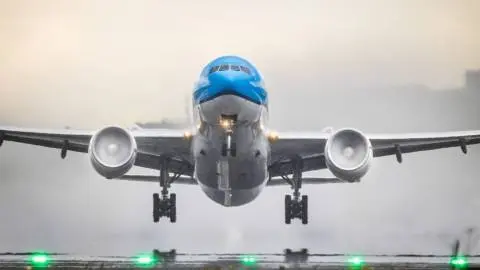Sustainable Aviation Fuels are the greener option that must take flight
Sustainable aviation fuels are the key mid-term solution to cut aviation emissions. Despite ambitious 2030 targets, blend rates remain low. Supply lags behind announcements, and demand needs a boost. Policy mandates can be met, but diverse feedstocks and regional acceptance complicate supply-demand matching
SAF-route is indispensable to start reducing net-emissions in aviation
The aviation industry has faced extraordinary challenges in recent years but has rebounded strongly from the pandemic, with ongoing high demand for air travel, especially in Asia, where travel propensity is high despite flights per head being far lower than in the US, for example. A constant factor is the urgent need to reduce emissions, as the sector is among the hardest to abate. Its current 2% share* in global GHG emissions could quickly rise if no changes are made and demand reduction is ignored.
Most airline emissions come from longer-haul flights over 1,500 km. Realistically, there is no clean and commercially scalable alternative technology for longer journeys yet. With the highest safety standards and significant investments in R&D, introducing a new generation of aircraft usually takes up to 20 years, and order books for the current generation already extend well into the 2030s.
Fleet renewal programmes are a crucial part of airline strategies to reduce seat emissions. However, aircraft life cycles are long, there are delays, and these measures alone are insufficient. Therefore, sustainable aviation fuels (SAF) play a critical role in making flying more sustainable despite concerns about sourcing, efficiency, and the required lifecycle assessment (LCA) for emissions, also known as 'well-to-wake'. While SAFs still emit CO2 during combustion, the CO2 savings are generated earlier in the supply chain through the use of bio-feedstock. This approach faces criticism due to land use and potential competition with other uses, but there are no easy alternatives.
The lifecycle emissions from SAFs and their feedstocks vary widely, with different levels of regional acceptance. This means some SAFs offer significantly more carbon reduction potential compared to conventional jet fuel.
*This excludes the climate impact of non-CO2 emissions (nitrogen emissions, particles, and water vapour) from jet fuel combustion at high altitudes, which is still under investigation but is estimated to be significant.
Several variants in play, with BioSAFs covering the far majority
Previously, we explored the various production routes for variants of Sustainable Aviation Fuels, their economics, and the regional blending mandates and ambitious corporate goals driving their adoption. It's evident that a stronger supply is needed to meet these ambitions. BioSAF, and particularly those produced via the HEFA process, constitutes the majority of supply and offers the best economic proposition for short-term scaling.
All SAF types are expected to remain more expensive than conventional jet fuel. Conventional jet fuel typically accounts for 20-35% of total airline costs, which is significant in the low-margin aviation sector; someone has to bear the premium cost, which is a major challenge. The global and regional supply and demand dynamics of SAF are evolving, as is the thinking about how to navigate these changes and the actions of market players.
In this piece, we will focus on regional supply and demand developments for biogenic SAFs up to 2030, as well as the feedstocks behind these SAFs. What is the current dynamic, where are we heading, and what challenges do we face in pushing for widespread adoption? Synthetic SAFs will also start to play a role, but due to high costs, availability constraints for green hydrogen, and inefficiencies, we only expect significant uptake from 2030 onwards. We have examined the economics of synthetic SAF, and you can read about it here.
The world wants sustainability, so now comes the action
The global aviation authority ICAO aims to reduce emissions by 5% in 2030 through SAF blending. On the private side, IATA targets a 6% blend, while collectives like ‘Clean Skies for Tomorrow’ and ‘One World Group’ (including airlines such as American, Qantas, and Cathay Pacific) aim for 10% by 2030. Europe’s largest airline by passenger numbers, Ryanair, has committed to 12.5%. With an expected blend rate of just 0.5% in 2024, it’s clear there’s much work to be done in the next six years.
Governments worldwide have introduced blend mandates ranging from 1% by 2025 (Malaysia) to 10% by 2030 (UK) to encourage uptake. However, these efforts are fragmented, and targets alone are insufficient. Public (‘hard’) targets are more compelling, and shortfalls may lead to fines in countries like Germany.
With SAF prices unlikely to match conventional jet fuel, more policy support is needed to turn aspirations into acceleration. Under current policies, the IEA expects bio-jet fuel to make up just 2% of global jet fuel consumption by 2030. In Europe, the emission trading scheme (ETS) helps create a more level playing field with conventional jet fuel, but additional measures are likely needed to achieve significant progress
Short term vs. long term SAF market
Airlines worldwide are beginning to blend SAF into their fuel supply. They can secure SAF supply by participating in investment initiatives, making long-term commitments, or relying on the spot market. Off-take agreements are a common method for ensuring future deliveries. These agreements also provide insight into future blend rates, demonstrating airlines’ commitment to sustainable sourcing
SAF blending has started, but more support is needed to get beyond 2%
Expected blend rates* towards 2030 in two scenarios

Expected global SAF blend rates far from stated goals
Global conventional jet fuel consumption is projected to rise to 6.6 million barrels per day (306 million tonnes) in 2024, with further increases expected in the coming years. The current small fraction of SAF is anticipated to grow to 3.5% by 2030 in an energy transition scenario (BNEF), assuming greater policy alignment. However, under the current stated policies scenario, the IEA expects this to reach only 2%. Both projections fall short of the targets set by the global aviation industry and individual airlines.
Airlines need to speed up SAF progress
European airlines are leading the way in SAF adoption, but there are significant differences among them. DHL Group, which operates freighters, is ahead, having successfully marketed SAF to B2B clients. Air France-KLM follows as a passenger airline, while other major European airlines like IAG (including British Airways) and Lufthansa began their SAF journey in 2023. However, many other airlines are just starting by preparing their supply chains.
In 2024, we expect to see progress in SAF blending, with Ryanair, for example, increasing SAF usage on specific routes in Europe. On the other hand, the overall climate strategy has faced setbacks due to various challenges. For instance, Air New Zealand has dropped its 2030 climate target.
European airlines ahead in SAF-blending, but still need to ramp up quickly
Ranking SAF Blend rates, airlines 2023, per region

Three reasons why blend rates are not yet on track to meet targets
- Slower than expected realization of production facilities (particularly in Europe)
- Global airline traffic and jet fuel demand have massively rebounded, surging 20% in 2023 and 2024 combined. Volume eventually recovered faster than expected at the point of target setting. This means SAF volumes will need to progress even more.
- Airlines struggle to pass on the premium to private consumers on a voluntary basis. And the return of margin pressures also led to profit warnings in 2024. Required cost discipline could have a slowdown effect on short term blending efforts.
Europe and the US are expected to lead in SAF adoption, while Africa and Latin America lag behind. In the Asia-Pacific region, the world’s largest and fastest-growing air traffic market, SAF blending is emerging. However, due to the high pace of expected growth and fragmented policy structures, increasing blend rates is expected to progress more slowly in the years leading up to 2030.
SAF will be sourced regionally, but Europe to remain reliant on imports
Sustainable Aviation Fuel (SAF) is expected to be sourced locally and initially supplied to relevant hubs. However, global trade flows will also play a role, involving either the feedstocks or the refined products. North America, Latin America, and Asia are anticipated to be exporters, while the EU market is expected to remain in deficit and continue importing feedstocks and SAF. Additionally, the eligibility of feedstocks varies by region and country, adding another layer of complexity to these trade flows.
North America expected to be the main producer of SAF by 2030
Forecasted production capacity in million tonnes of SAF

A regional flavour to the feedstock mix used for SAF production
Overview of some of the most relevant types of feedstock per region, including their reduction potential compared to emissions from conventional jet fuel

This publication has been prepared by ING solely for information purposes irrespective of a particular user's means, financial situation or investment objectives. The information does not constitute investment recommendation, and nor is it investment, legal or tax advice or an offer or solicitation to purchase or sell any financial instrument. Read more
Download
Download article
25 September 2024
Sustainable Aviation Fuels: SAFs are paving the way for greener skies This bundle contains 4 Articles


